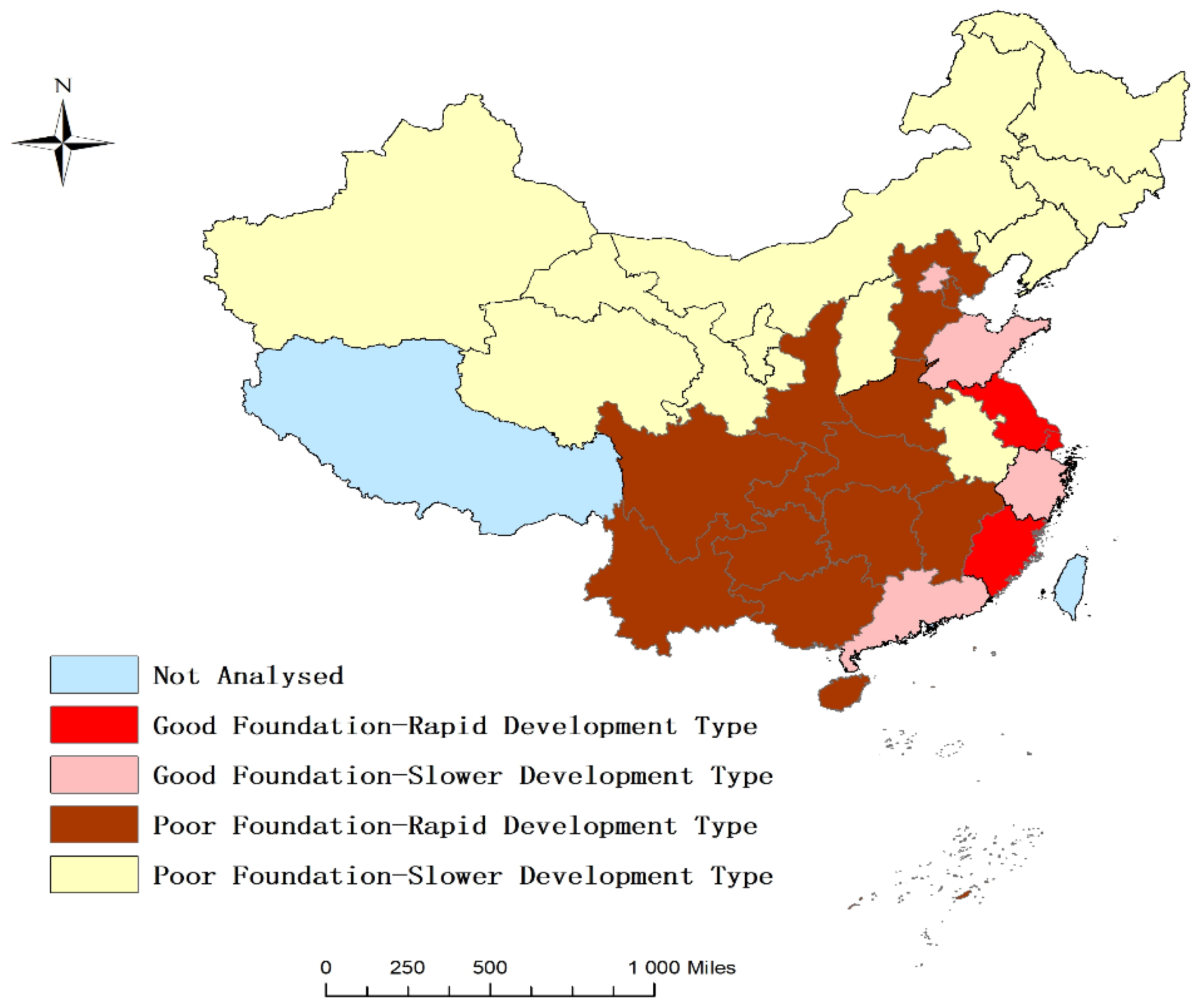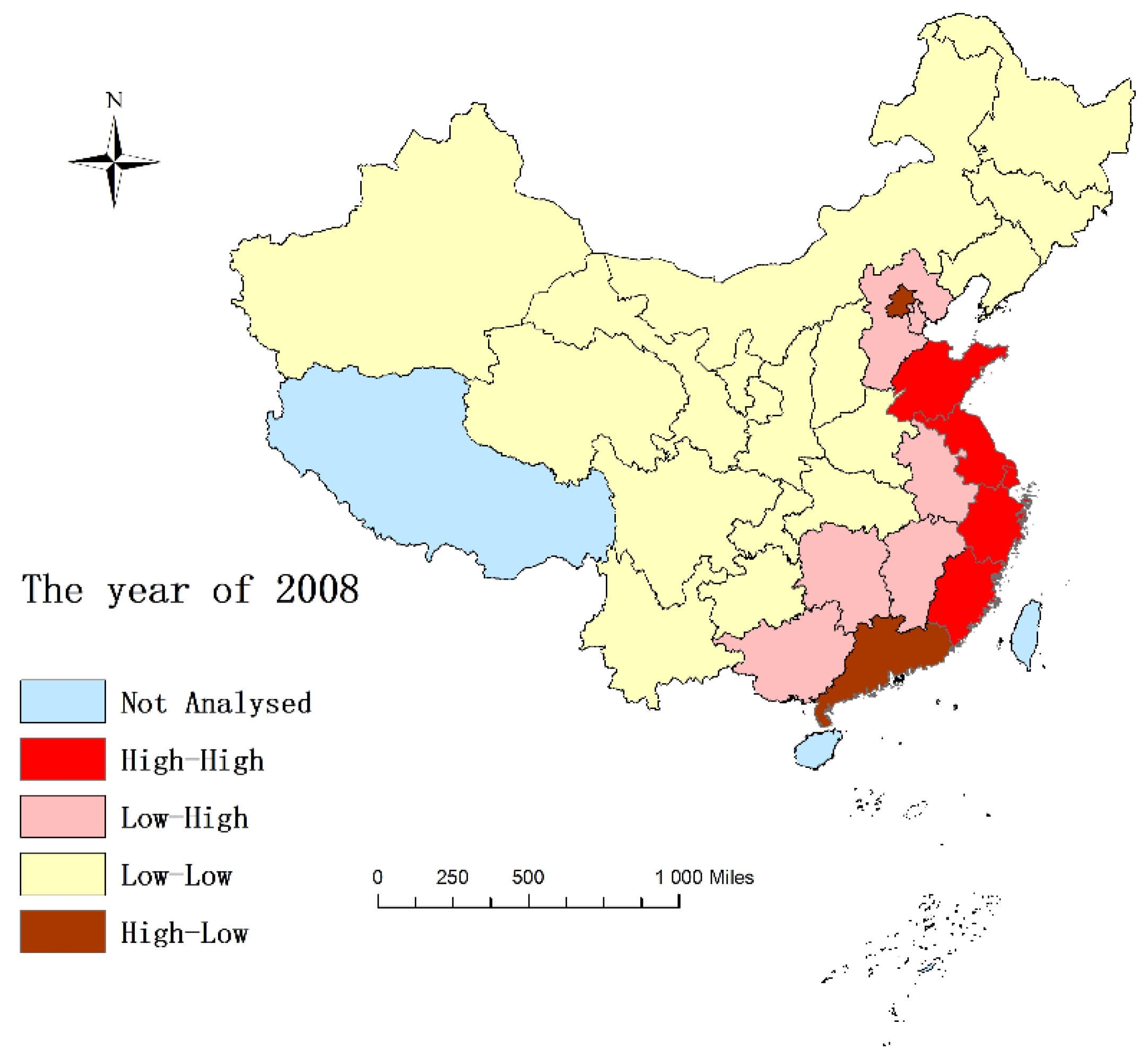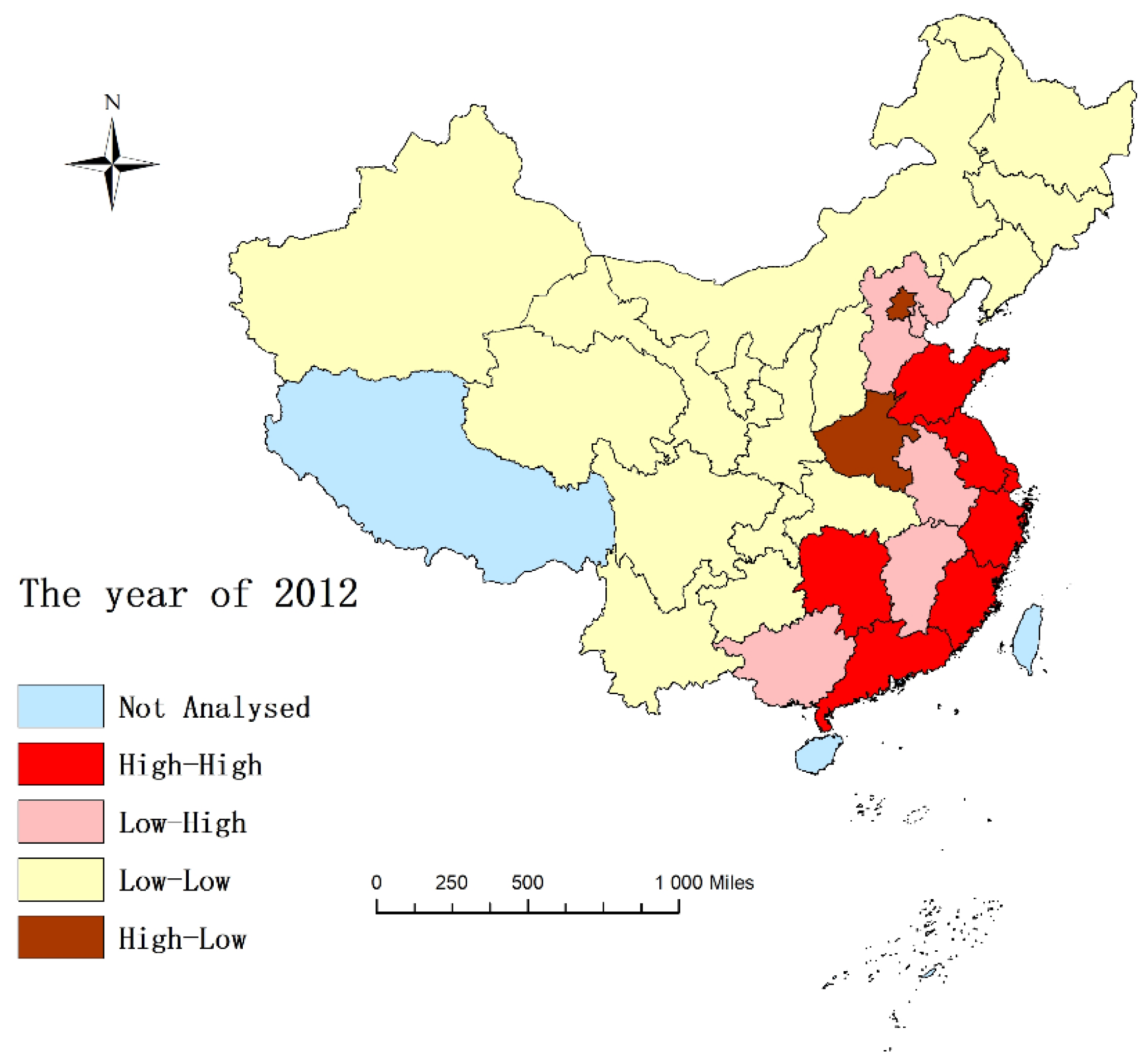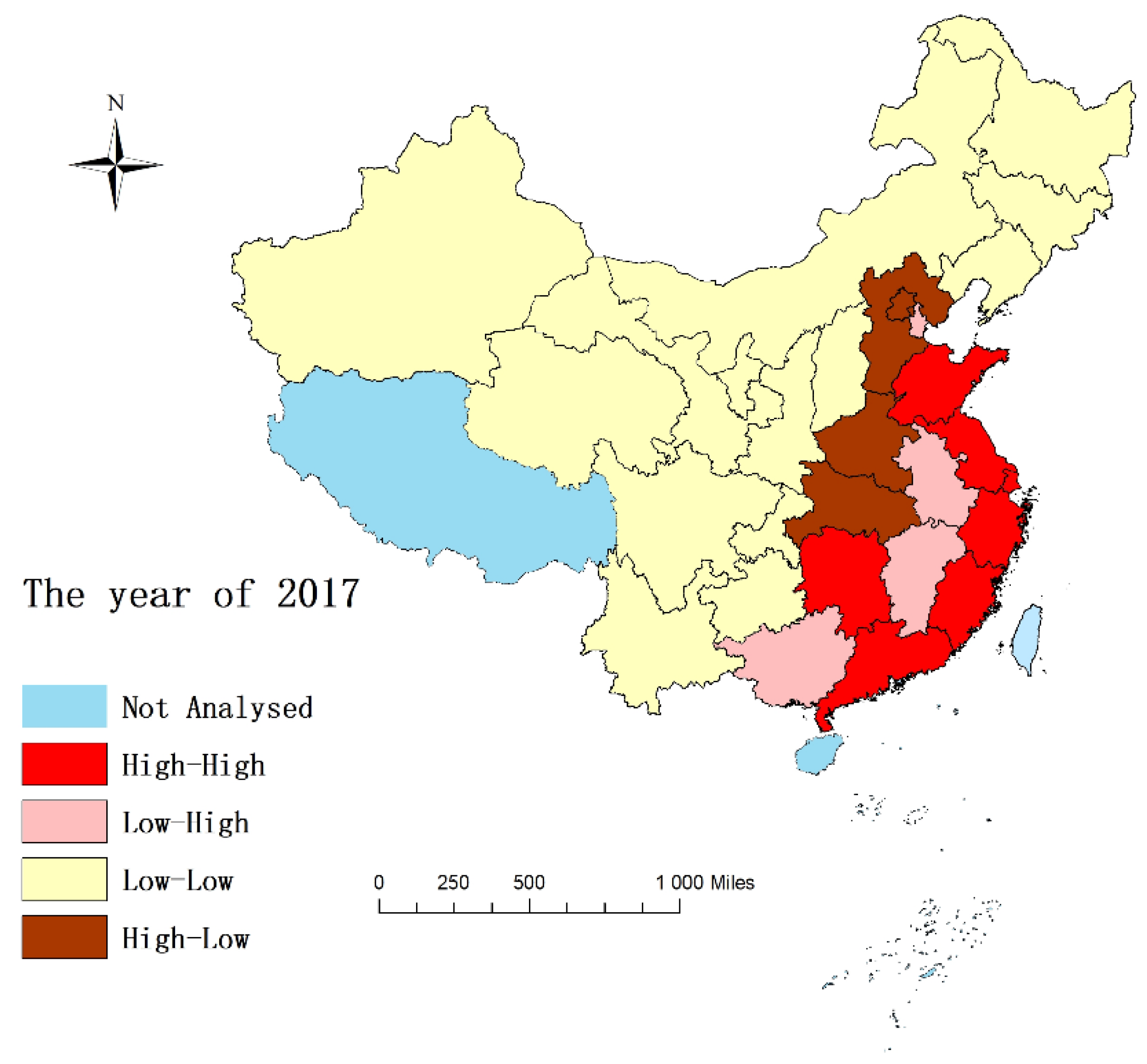Sports Industry Agglomeration and Green Economic Growth—Empirical Research Based on Panel Data of 30 Provinces and Cities in China
Abstract
:1. Literature Review
2. Variable Selection and Research Methods
2.1. Variable Selection
2.1.1. Dependent Variable (Explained Variable)
2.1.2. Independent Variable (Explanatory Variable)
2.1.3. Controlled Variable
2.2. Research Methods
3. Spatial Econometric Analysis of China’s Sports Industry Agglomeration
3.1. Analysis of the Current Situation of China’s Sports Industry Agglomeration
3.2. Exploratory Spatial Data Analysis (ESDA) of Sports Industry Agglomeration
3.2.1. Global Spatial Autocorrelation Analysis
3.2.2. Local Spatial Autocorrelation Analysis
4. Empirical Analysis of the Impact of Sports Industry Agglomeration on Green Economy
4.1. Model Construction
4.2. Empirical Analysis of Static Panel Models
4.2.1. Linear Relational Regression Analysis
4.2.2. Nonlinear Relationship Analysis
4.2.3. Regional Difference Analysis
4.3. Dynamic Panel Regression Analysis
5. Conclusions and Discussion
- Most of the provinces with a good foundation for the development of China’s sports industry are concentrated along the southeast coast. Under the strong support and guidance of national policy, the provinces along the Yangtze River Economic Belt with poor sports industry accumulation have shown a relatively fast development trend, resulting in the formation of more mature industrial clusters of sports goods, sports services and others in the Yangtze River Economic Belt.
- There is the characteristic of positive spatial aggregation in the development of China’s sports industry. Provinces of the same type of development have adjacent characteristics in spatial distribution, with a good inter-provincial connectivity. It is especially after 2012 that the development of sports industry concentration shows a strong space spillover effect.
- In the spatial separation pattern, the provinces in the “high–high” quadrant gradually increase or decrease and stabilize, the provinces in the “low–low” quadrant gradually decrease and then transfer to the “high–high” and “high–low” quadrants.
- Static and dynamic panel models show that the sports industry agglomeration has a significant role in promoting green economic growth with an “inverted U-shaped” relationship, that is, when the sports industry agglomeration is suitable, it is conducive to green economic growth. When the agglomeration level exceeds a certain threshold, it is not conducive to green economic growth. Meanwhile, there are significant regional differences in the impact of sports industry concentration on green economic growth influenced by the difference in the level of development of the sports industry, which is shown to be the strongest in the central region, second in the east and lowest in the west.
- Among the control variables, economic development, industrial structure upgrading and regional innovation level significantly promote the growth of green economy, and the eastern region should pay attention to the upgrading and transformation of industrial structure and improve the level of enterprise innovation.
- The development of sports industry in various regions of China is uneven, and the development of sports industry in the western region is dilatory, influenced by the restrictions of economic development level, natural environment and resource endowment. Therefore, the government should conduct overall planning and resource integration, enhancing the policy support for the sports industry in the western region, so as to build a good external environment for the development of the sports industry in the western region.
- Province-to-province and region-to-region exchange and cooperation should be strengthened, a coordinated development mechanism should be established, and the establishment of strategic cooperation between cross-regional “sports plus” and other industrial groups should be encouraged, while breaking the regional boundaries and realizing the complementary advantages and resource integration optimization of each region. The eastern and central regions should be encouraged to support the western region with technology and talents, promoting the balanced development of the sports industry to achieve a benefit-sharing.
- Industrial agglomeration of sports industry in the eastern and central regions is higher than that in the western regions. In the future, it will be necessary to correctly play the role of government intervention and market mechanism and to mobilize the enthusiasm of social subjects; the sports industry has shifted from a “high speed” to a “high quality” development model.
- Economic development, industrial structure upgrading and regional innovation level improvement have a positive effect on the growth of green economy. It shall release the superposition effect of various powers, lay stress on the transformation and upgrading of industries, encourage enterprises to carry out technological innovation, reduce the damage to the ecological environment in the process of promoting urbanization, thus truly achieve the green development. While playing the role of the market mechanism “invisible hand”, it shall strengthen the government’s macro-control, play the role of “tangible hand”, and establish a clear policy orientation, to promote the sustainable development of the green economy.
Author Contributions
Funding
Acknowledgments
Conflicts of Interest
References
- Wang, J.N.; Li, X.L.; Ge, C.Z. Current Situation and Prospect of Green Economy Development in China. Environ. Protect. 2009, 5, 535–536. [Google Scholar]
- Yang, F. Research on China’s Sports Industry Fiscal Policy from the Perspective of Green Economy. J. Shenyang Sport Univ. 2019, 3, 54–62. [Google Scholar]
- Porter, M.E. The competitive advantage of nations. Harv. Bus. Rev. 1990, 2, 73–93. [Google Scholar]
- Wang, Y.; Wang, Y.; Yin, G.W.; Xiao, Q.L. Space-Time Dynamic Changes of Sports Industry’s Spatial Agglomeration from the Perspective of Spatial Association: An Empirical Analysis Based on the ESDA. J. Xi’an Inst. Phys. Educ. 2018, 3, 2812–2888. [Google Scholar]
- Dan, Y.F. Essence, Features and Future of Green Sports. J. Wuhan Inst. Phys. Educ. 2013, 5, 323–325. [Google Scholar]
- Krugman, P. Increasing Returns and Economic Geography. J. Political Econ. 1991, 3, 4834–4899. [Google Scholar] [CrossRef]
- Clancy, P.; Malley, E.; Connell, L.; Van Egcraat, C. Industry Clusters in Ireland: An Application of Porter’s Model of National Competitive Advantage to Three Sectors. Eur. Plan. Stud. 2001, 1, 72–78. [Google Scholar] [CrossRef]
- Eliison, G.; Glaeser, E.L. Geographic concentration in U.S. manufacturing industries: A dartboard approach. J. Political Econ. 1994, 5, 889–927. [Google Scholar]
- Krugman, P.; Venables, A.J. Globalization and the inequality of nations. Q. J. Econ. 1995, 4, 8478–8480. [Google Scholar]
- Baldwin, R.; Martin, P. Agglomeration and regional growth. Handb. Reg. Urban Econ. 2006, 4, 2671–2711. [Google Scholar]
- Ottaviano, G.I.P.; Martin, P. Growth and agglomeration. Int. Econ. Rev. 2001, 4, 947–968. [Google Scholar]
- Yu, B.B.; Yang, H.X.; Jin, G. Can industrial agglomeration improve regional economic efficiency—Based on the spatial measurement analysis of Chinese urban data. J. Zhongnan Univ. Econ. Law 2015, 3, 1211–1230. [Google Scholar]
- Cao, Q.F.; Wang, J.T.; Yang, T. The Effects of Cultural Industrial Agglomeration on Regional Economic Growth Based on the Spatial Econometric Method. J. Xi’an Jiaotong Univ. 2014, 5, 515–517. [Google Scholar]
- Ji, Y.J.; Zhou, S.J. The Regional Economic Growth Effect of China’s Financial Industry Agglomeration—Empirical Research Based on Threshold Regression Model. Rev. Ind. Econ. 2015, 2, 43–51. [Google Scholar]
- Yu, J.K.; Liu, X.H.; Shan, C.H. Research on the Impact of Marine Industry Agglomeration on Economic Growth: GMM Method Based on Dynamic Panel Data. Dong Yue Trib. 2014, 2, 1401–1443. [Google Scholar]
- Zhou, J.W.; Jiang, Z.Y.; Li, F. The Impact of Tourism Industry Agglomeration on the Efficiency of Green Economy: An Empirical Research Based on Provincial Panel Data. Ecol. Econ. 2019, 3, 1221–1228. [Google Scholar]
- Hu, A.J.; Guo, A.J.; Zhong, F.L.; Wang, X.B. Can the high-tech industrial agglomeration improve the green economic efficiency of the region. China Popul. Resour. Environ. 2018, 9, 93–101. [Google Scholar]
- Yao, S.B.; Liu, Y. An Empirical Analysis of the Impact of Sports Industry Agglomeration on Regional Economic Growth—Based on Static and Dynamic Panel Data Model. China Sport Sci. 2017, 11, 21–29, 39. [Google Scholar]
- Ji, Y.H.; Cao, X.G. The Effects of Knowledge Spillovers of Industrial Agglomeration on Regional Economic Disparity—Comparative Study on Manufacturing Industry and Service Industry. Forum Sci. Technol. China 2017, 12, 106–113. [Google Scholar]
- Cao, W.B.; Zhang, Y.; Qian, P. The Effect of Innovation-Driven Strategy on Green Economic Development in China-An Empirical Study of Smart Cities. Int. J. Environ. Res. Public Health 2019, 9, 1520. [Google Scholar] [CrossRef]
- Zhou, Y.; Jiang, J.J.; Ye, B.; Hou, B. Green spillovers of outward foreign direct investment on home countries: Evidence from China’s province-level data. J. Clean. Product. 2019, 215, 829–844. [Google Scholar] [CrossRef]
- Song, X.G.; Zhou, Y.X.; Jia, W. How do Economic Openness and R&D Investment Affect Green Economic Growth? Evidence from China. Resour. Conserv. Recycl. 2019, 146, 405–415. [Google Scholar]
- Ren, Y.J.; Wang, C.X. Research on the Spillover Effects of Food Industry Agglomeration on Green Economic Efficiency: Including Tropical Fruit Industry. Arch. Latinoam. Nutr. 2018, 4, 2872–2896. [Google Scholar]
- Li, K.F.; Wang, J. Financial Agglomeration, Industrial Structure and Environmental Pollution—Spatial Econometric Analysis Based on China’s Provinces. Ind. Technol. Econ. 2017, 3, 31–32. [Google Scholar]
- Xie, T.T.; Liu, J.H. Financial Agglomeration, Industrial Structure Upgrade and Green Economic Growth. Wuhan Financ. Mon. 2019, 2, 515–516. [Google Scholar]
- Wang, Z.X.; Zhang, H.Z.; Gong, X.S.; Wang, Y. Logistics Industry Agglomeration, Market Segmentation and Regional Green Economic Efficiency. Econ. Surv. 2018, 5, 87–93. [Google Scholar]
- Zhang, N. Green Economy and Development on Western China Sports Industry. J. Chengdu Phys. Educ. Inst. 2001, 6, 373–379. [Google Scholar]
- Wang, F.; Li, J.X.; Chen, J.G.; Liu, J.; Wu, C. Population density, energy consumption and the development of green economy-Empirical analysis based on Provincial Panel Data. J. Arid Land Resour. Environ. 2017, 1, 61–62. [Google Scholar]
- Zhou, Z.H.; Li, X.Y.; Chen, R.Y. Evaluating the Policy Effect of Regional Sport Industry’s Agglomeration and Growth—New Evidence from the Synthetic Control Methods. Finance Econ. 2018, 7, 1211–1232. [Google Scholar]
- Taskin, F.; Zaim, O. The Role of International Trade on Environmental Efficiency: A DEA Approach. Econ. Model. 2001, 1, 11–17. [Google Scholar] [CrossRef]
- Zeng, D.Z.; Zhao, L. Pollution Havens and Industrial Agglomeration. J. Environ. Econ. Manag. 2009, 58, 1411–1453. [Google Scholar] [CrossRef]
- Koji, S.; Yoshitaka, T.; Kei, G.; Matsuoka, Y. Developing a Long-term Local Society Design Methodology towards a Low-carbon Economy: An Application to Shiga Prefecture in Japan. Energy Policy 2007, 9, 4688–4703. [Google Scholar]
- Jing, X.Q. Industrial structure and economy growth—The Analysis of Yangtze River Delta area. J. Nantong Univ. 2005, 3, 454–459. [Google Scholar]
- Xia, H.L.; Ye, A.S.; Zhou, X. High-tech Industry Development and Regional Industrial Structure Upgrade: Empirical Research Based on Provincial Panel Data. Sci. Technol. Manag. Res. 2019, 4, 1661–1673. [Google Scholar]
- Yang, R.; Chen, W. Spatial Correlation, Influencing Factors and Environmental Supervision on Mechanism Construction of Atmospheric Pollution: An Empirical Study on SO2 Emissions in China. Sustainability 2019, 11, 1742. [Google Scholar] [CrossRef]
- Xu, J.F.; Yang, R.Y.; Liu, R.; Ren, W.N. Vitamin Nutritional Status and Spatial Differentiation Characteristics of Chinese National Physical Fitness. Arch. Latinoam. Nutr. 2019, 2, 81–90. [Google Scholar]
- Wei, D.X.; Lei, W. Spatial Heterogeneity of Chinese Sports Lottery Sales and Driving Factors based ESDA-GWR. J. Tianjin Univ. Sport. 2013, 4, 304–309. [Google Scholar]
- Wu, J.; Hu, Y.H. Reconstruction of the Economic Function of the Sports Industry in the Yangtze River Economic Belt under the “New Normal”. J. Nantong Univ. (Soc. Sci. Ed.) 2015, 4, 17–22. [Google Scholar]
- Bei, J.; Gang, L. Green Economic Growth from a Developmental Perspective. China Finance Econ. Rev. 2013, 1, 95–118. [Google Scholar]
- Huang, H.; Xu, Q. Study on the Influence of Population Mobility and Industrial Structure Transformation upon Green GDP of Shanghai. China Soft Sci. 2017, 4, 94–108. [Google Scholar]
- Xu, N.; Shi, B.Z.; Tang, X.X.; Deng, M. Research on Financial Agglomeration and Green Economy Efficiency Based on Spatial Durbin Model. Resour. Dev. Market. 2018, 10, 1340–1347. [Google Scholar]
- Liu, Y.B.; Yuan, H.X.; Wang, Z. Dynamic panel data modeling of the effects of cultural industry clusters on green economic efficiency. Resour. Sci. 2017, 4, 747–755. [Google Scholar]
- He, L.D.; Wang, Y.J.; Zhang, X.N. Fiscal Decentralization, Expenditure of Energy Saving and Environmental Protection and Green Development. Rev. Econ. Manag. 2018, 6, 253–255. [Google Scholar]
- Ye, C.S.; Hui, L. The Impact of Agricultural Public Financial Expenditure on China’s Agricultural Green Productivity. Wuhan Univ. J. Philos. Soc. Sci. 2016, 3, 48–55. [Google Scholar]
- Lin, B.Q.; Tan, R.P. China’s Economic Agglomeration and Green Economic Efficiency. Econ. Res. J. 2019, 2, 119–132. [Google Scholar]
- Xu, K.J.; Huang, H.Y.; Lian, T.; Li, G.; Ren, B. Path and Key Issues of High-quality Development of Sports Industry in China. J. Shanghai Univ. Sport 2019, 4, 293–297. [Google Scholar]





| Variable Name | Symbol | Description | |
|---|---|---|---|
| Explanatory variable | Sports industry agglomeration degree | CI | The degree of sports industry agglomeration |
| Explained variable | Green GDP | GGDP | GDP—cost of resource depletion—cost of environmental pollution loss |
| Controlled variables | Economic development | Eco | Per capita GDP |
| Human capital | Hr | Average years of education | |
| Urbanization level | Urb | The proportion of urban population to the total population | |
| Foreign investment level | Fdi | The ratio of FDI to GDP after exchange rate conversion | |
| Regional innovation level | Inn | Number of regional patent authorizations/10,000 people | |
| Government intervention degree | Gov | Ratio of local fiscal expenditure to GDP | |
| Industrial structural upgrade | Upgrade | Industrial structure hierarchy coefficient |
| Type | 2008 | 2012 | 2017 |
|---|---|---|---|
| H-H (The first quadrant) | Fujian, Shanghai, Jiangsu, Zhejiang, Shandong (5) | Fujian, Shanghai, Jiangsu, Zhejiang, Shandong, Guangdong, Hunan (7) | Fujian, Shanghai, Jiangsu, Zhejiang, Shandong, Guangdong, Hunan (7) |
| L-H (The second quadrant) | Jiangxi, Tianjin, Guangxi, Anhui, Hebei, Hunan (6) | Jiangxi, Tianjin, Guangxi, Anhui, Hebei (5) | Jiangxi, Tianjin, Guangxi, Anhui (4) |
| L-L (The third quadrant) | Heilongjiang, Inner Mongolia, Jilin, Shanxi, Shaanxi, Hubei, Chongqing, Guizhou, Qinghai, Gansu, Ningxia, Liaoning, Yunnan, Sichuan, Xinjiang, Henan (16) | Heilongjiang, Inner Mongolia, Jilin, Shanxi, Shaanxi, Hubei, Chongqing, Guizhou, Qinghai, Gansu, Ningxia, Liaoning, Yunnan, Sichuan, Xinjiang (15) | Heilongjiang, Inner Mongolia, Jilin, Shanxi, Shaanxi, Chongqing, Guizhou, Qinghai, Gansu, Ningxia, Liaoning, Yunnan, Sichuan, Xinjiang, (14) |
| L (The fourth quadrant) | Beijing, Guangdong (2) | Beijing, Henan (2) | Beijing, Henan, Hebei, Hubei (4) |
| Pooled OLS Regressions | Fixed Effect Model | Random Effect Model | |
|---|---|---|---|
| LnCI | 8.3155 *** | 1.0532 * | 0.6116 |
| (10.15) | (1.90) | (1.03) | |
| LnEco | 1.3707 *** | 1.1240 *** | 1.1662 *** |
| (8.83) | (16.95) | (16.56) | |
| LnUpgrade | 1.6495 | 1.3746 *** | 1.4207 *** |
| (1.32) | (3.22) | (3.06) | |
| LnHr | 0.6630 *** | 0.0491 | 0.0456 |
| (6.24) | (1.33) | (1.14) | |
| LnUrb | 12.0063 *** | 0.3891 | 0.3238 |
| (8.62) | (0.57) | (0.46) | |
| LnFdi | −0.2461 *** | −0.0488 * | −0.0785 *** |
| (−2.78) | (−1.77) | (−2.70) | |
| LnInn | 0.4060 *** | 0.0595 * | 0.0817 ** |
| (6.05) | (1.67) | (2.12) | |
| LnGov | 0.9246 *** | 0.0797 | 0.3857 ** |
| (7.55) | (0.41) | (2.25) | |
| _cons | −8.7823 | −10.3623 *** | −10.6449 *** |
| (−1.23) | (−4.42) | (−4.17) | |
| N | 300 | 300 | 300 |
| F | 117.0244 | 592.7237 | |
| Wald | 3979.85 | ||
| R2 | 0.7678 | 0.9476 | 0.9460 |
| P | 0.0000 | 0.0000 | 0.0000 |
| Pooled OLS Regressions | Fixed Effect Model | Random Effect Model | |
|---|---|---|---|
| LnCI | 3.3997 *** | 2.0328 *** | 1.0333 * |
| (5.64) | (3.70) | (1.79) | |
| LnCI2 | −27.6084 *** | −25.1976 *** | −22.9115 ** |
| (−3.50) | (−2.92) | (−2.40) | |
| LnEco | 1.2188 | 1.3334 *** | 1.4044 *** |
| (0.96) | (3.10) | (2.97) | |
| LnUpgrade | 0.6680 *** | 0.4496 *** | 0.4456 *** |
| (6.34) | (3.34) | (3.13) | |
| LnHr | 11.0798 *** | 0.8877 *** | 0.3805 |
| (8.25) | (3.89) | (0.54) | |
| LnUrb | 0.1577 * | 0.0468 * | 0.0793 *** |
| (1.79) | (1.69) | (2.69) | |
| LnFdi | −0.3438 *** | −0.0618 * | −0.0847 ** |
| (−5.09) | (−1.73) | (−2.17) | |
| LnInn | 0.8075 *** | 0.4838 ** | 0.4122 ** |
| (6.54) | (2.43) | (2.41) | |
| LnGov | 1.3034 *** | 1.1244 *** | 1.1692 *** |
| (8.38) | (16.95) | (16.45) | |
| _cons | −6.1320 | −10.1319 *** | −10.5542 *** |
| (−0.85) | (−4.30) | (−4.07) | |
| N | 300 | 300 | 300 |
| F | 113.3748 | 526.6616 | |
| Wald | 3894.71 | ||
| R2 | 0.7790 | 0.9478 | 0.9459 |
| P | 0.0000 | 0.0000 | 0.0000 |
| Eastern | Middle | Western | |
|---|---|---|---|
| LnCI | 1.5093 * | 2.0146 ** | 0.5171 |
| (1.74) | (2.06) | (1.37) | |
| LnEco | 0.8589 *** | 1.1249 *** | 1.2220 *** |
| (12.24) | (15.28) | (7.03) | |
| LnUpgrade | 2.3545 *** | 1.7306 * | 1.6392 * |
| (3.42) | (1.85) | (1.74) | |
| LnHr | 0.0378 | 0.0653 | 0.0587 |
| (0.96) | (1.61) | (0.75) | |
| LnUrb | 0.4100 | 0.0490 | 0.8169 |
| (0.64) | (0.05) | (0.40) | |
| LnFdi | −0.1101 *** | −0.0608 *** | −0.0056 |
| (−3.38) | (−2.87) | (−0.10) | |
| LnInn | 0.1433 *** | 0.0460 | 0.0048 |
| (3.49) | (1.00) | (0.06) | |
| LnGov | −1.0983 | 4.1781 | 0.0023 |
| (−1.39) | (5.01) | (0.01) | |
| _cons | −12.7033 *** | −3.1239 | −13.2732 ** |
| (−3.67) | (−1.04) | (−2.40) | |
| N | 110 | 70 | 120 |
| F | 437.3388 | 530.3557 | 160.8371 |
| R2 | 0.9746 | 0.9872 | 0.9279 |
| P | 0.0000 | 0.0000 | 0.0000 |
| Model | Fixed-effect | Fixed-effect | Fixed-effect |
| Model 1 | Model 2 | Eastern | Middle | Western | |
|---|---|---|---|---|---|
| L.lnggdp | 0.2809 *** | 0.2775 *** | 0.4302 *** | 0.7481 *** | 0.2264 ** |
| (11.41) | (11.57) | (3.83) | (12.46) | (2.30) | |
| LnCI | 2.1451 ** | 1.6159 ** | 1.7791 * | 2.2800 ** | 0.0713 |
| (2.07) | (2.01) | (1.90) | (2.32) | (0.02) | |
| LnCI2 | −16.7620 ** | ||||
| (2.21) | |||||
| LnEco | 0.6753 *** | 0.6701 *** | 0.3817 | 0.1061 | 1.5923 *** |
| (11.90) | (10.24) | (1.09) | (0.95) | (2.73) | |
| LnUpgrade | 0.489 *** | 0.935 *** | 6.0033 * | 0.7238 | 3.3056 * |
| (3.42) | (4.20) | (1.91) | (1.46) | (1.93) | |
| LnHr | 0.1419 *** | 0.1412 *** | 2.2773 *** | 1.0907 *** | 1.4535 |
| (15.86) | (14.87) | (4.94) | (4.43) | (1.23) | |
| LnUrb | 1.9283 ** | 1.7484 * | 4.9280 | 0.3257 | 8.0858 |
| (2.45) | (1.83) | (0.71) | (0.30) | (1.37) | |
| LnFdi | −0.0259 *** | −0.0223 *** | −0.2967 *** | −0.0232 | 0.1280 |
| (−3.47) | (−2.70) | (−2.66) | (−0.37) | (−1.16) | |
| LnInn | 0.3242 *** | 0.3153 *** | 0.1491 * | 0.0291 | 0.2503 *** |
| (11.81) | (11.07) | (1.85) | (0.66) | (4.85) | |
| LnGov | 1.2081 *** | 1.2291 *** | 3.6381 ** | 1.0809 | 0.1988 |
| (11.15) | (10.26) | (2.17) | (1.09) | (0.27) | |
| _cons | −0.3464 | −0.5564 | −34.0315 ** | 2.9595 | −19.1927 * |
| (−0.16) | (−0.21) | (−2.05) | (1.03) | (−1.79) | |
| N | 270 | 270 | 99 | 63 | 108 |
| AR (1) | −2.3714 ** | −2.3882 ** | −2.5331 ** | −2.3194 ** | −2.4223 ** |
| AR (2) | 0.9019 | 1.0034 | 0.9280 | 1.0291 | 0.0138 |
| Sargan | 0.9687 | 0.9737 | 1.0000 | 1.0000 | 1.0000 |
© 2019 by the authors. Licensee MDPI, Basel, Switzerland. This article is an open access article distributed under the terms and conditions of the Creative Commons Attribution (CC BY) license (http://creativecommons.org/licenses/by/4.0/).
Share and Cite
Xu, J.; Yang, R. Sports Industry Agglomeration and Green Economic Growth—Empirical Research Based on Panel Data of 30 Provinces and Cities in China. Sustainability 2019, 11, 5399. https://doi.org/10.3390/su11195399
Xu J, Yang R. Sports Industry Agglomeration and Green Economic Growth—Empirical Research Based on Panel Data of 30 Provinces and Cities in China. Sustainability. 2019; 11(19):5399. https://doi.org/10.3390/su11195399
Chicago/Turabian StyleXu, Jinfu, and Ruoyu Yang. 2019. "Sports Industry Agglomeration and Green Economic Growth—Empirical Research Based on Panel Data of 30 Provinces and Cities in China" Sustainability 11, no. 19: 5399. https://doi.org/10.3390/su11195399
APA StyleXu, J., & Yang, R. (2019). Sports Industry Agglomeration and Green Economic Growth—Empirical Research Based on Panel Data of 30 Provinces and Cities in China. Sustainability, 11(19), 5399. https://doi.org/10.3390/su11195399




